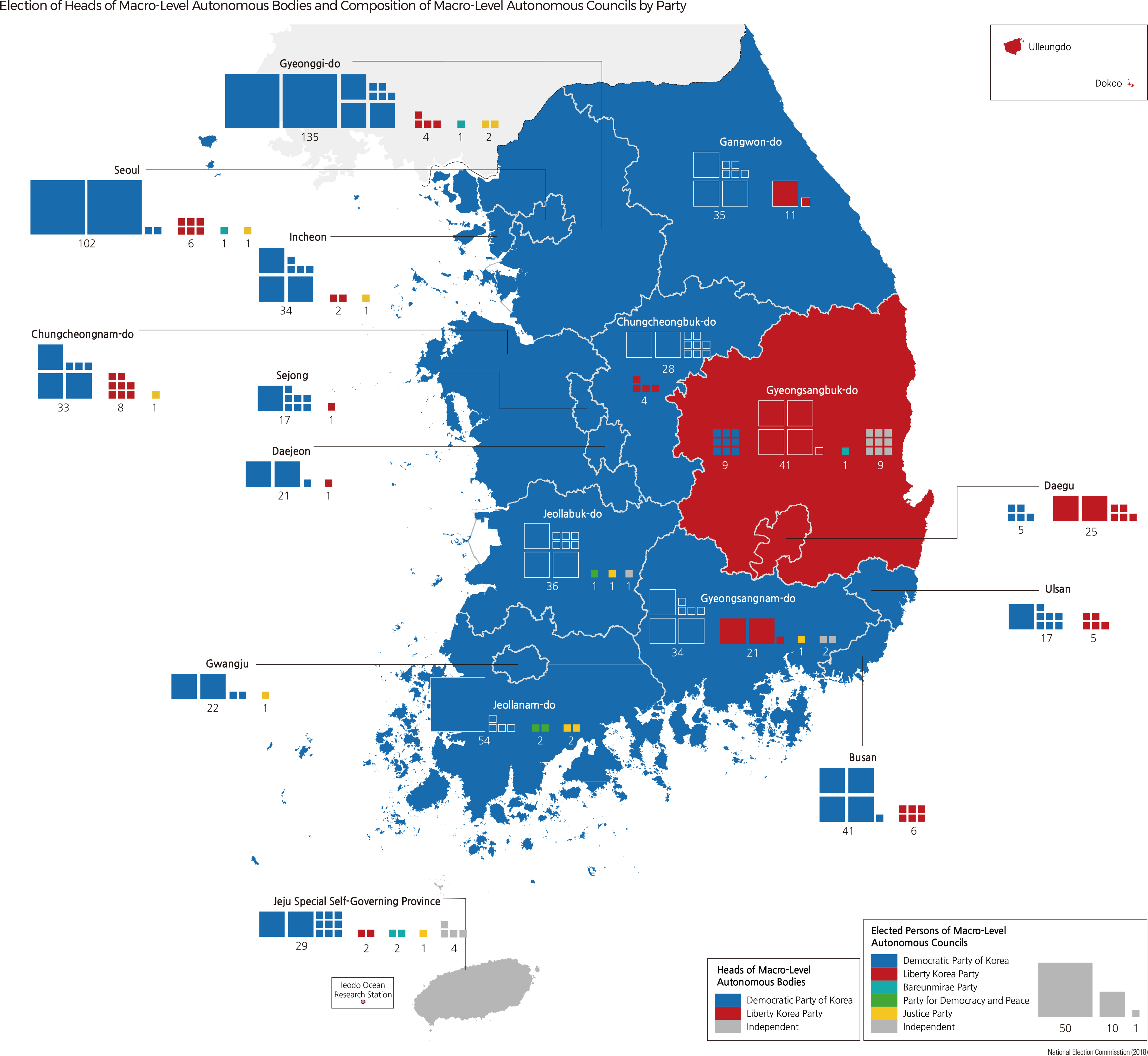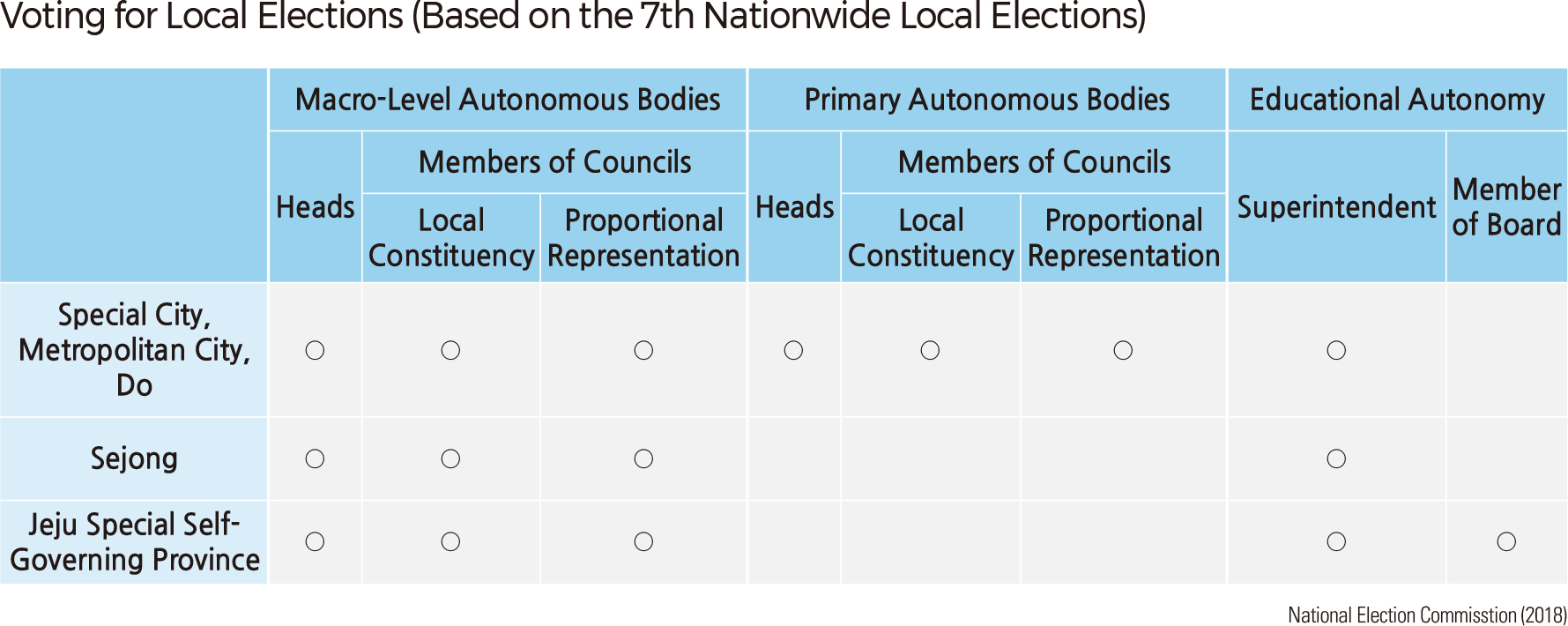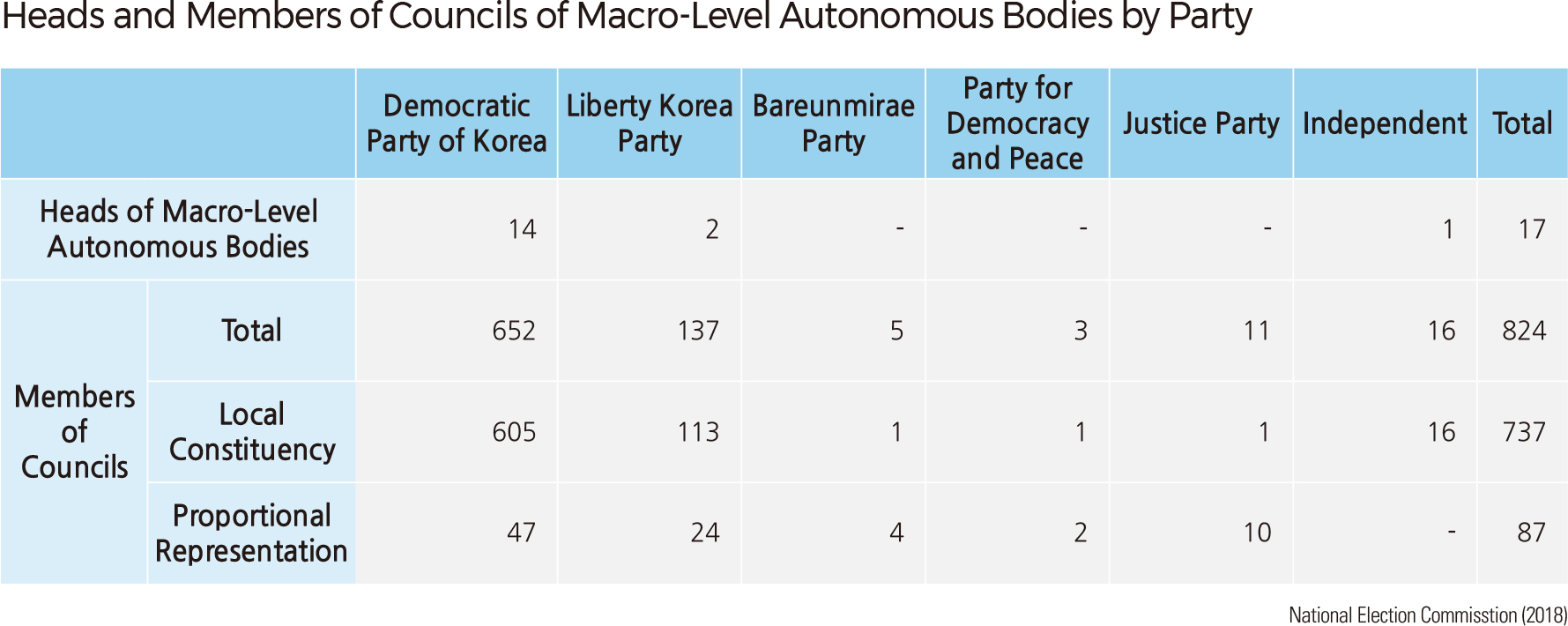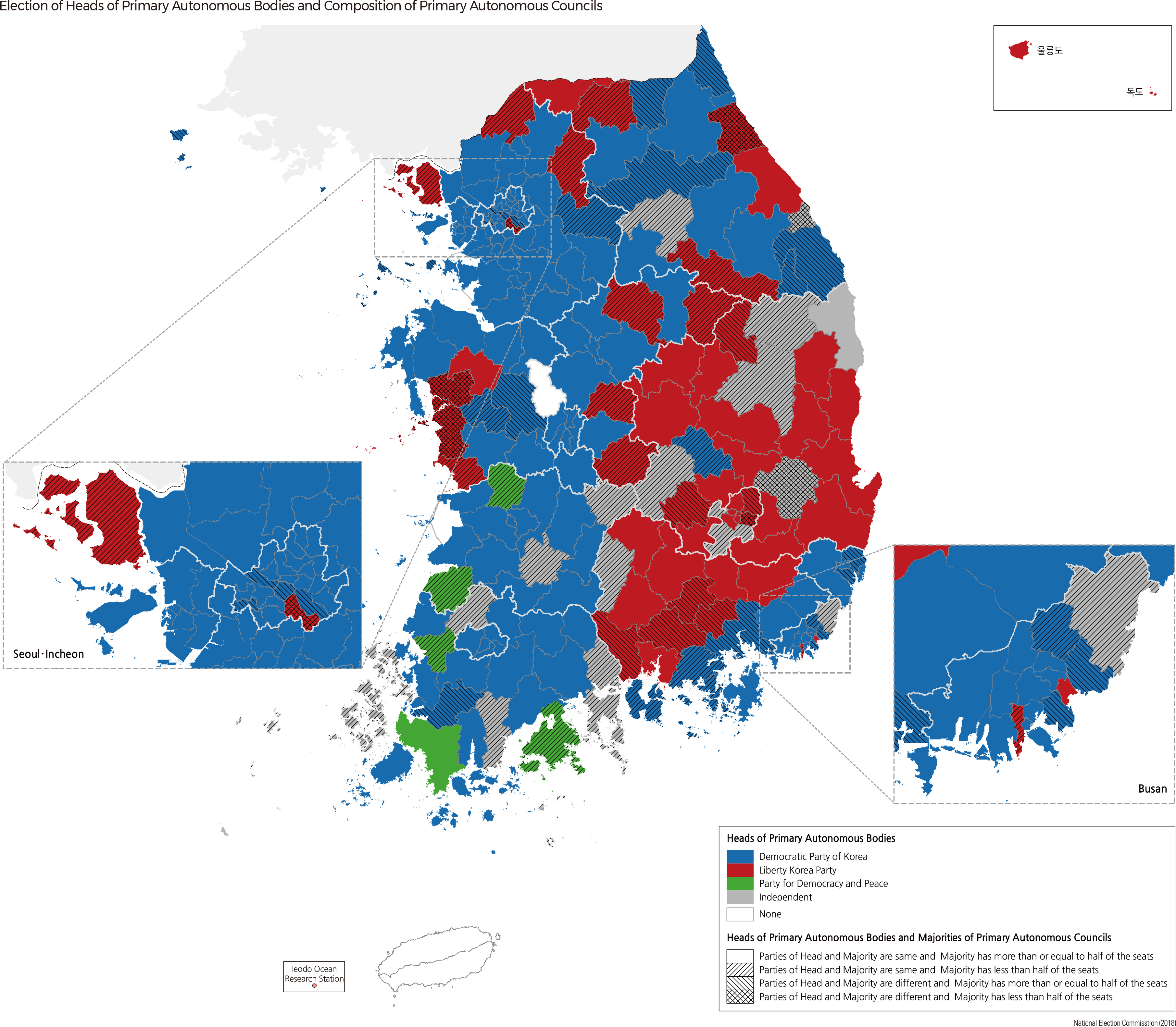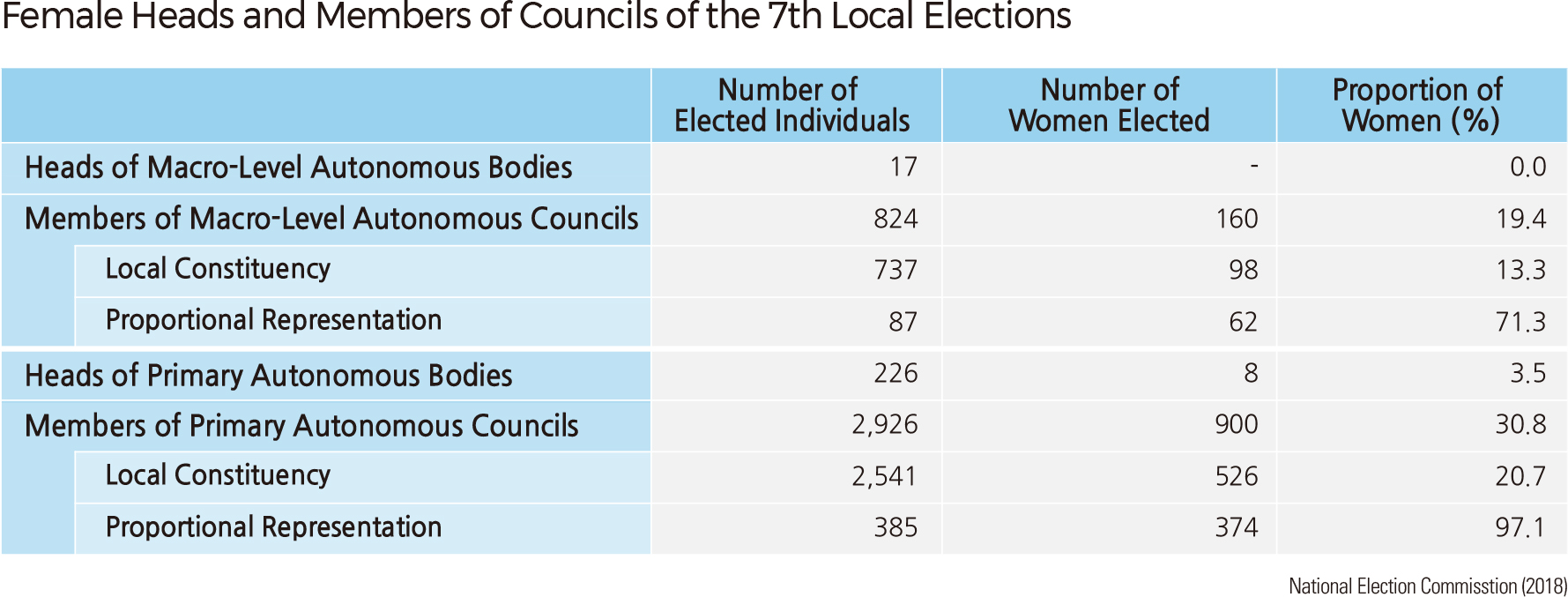English I 2019
Local elections in Korea were first introduced in 1952 and held until 1960. Subsequently, local elections were not held because the local council was then closed down by the military regime, and the central government appointed heads of primary autonomous bodies. After the amendment of the constitution in 1987, a local council election was held in 1991. In 1995, the first Nationwide Simultaneous Local Election was held. Nationwide Simultaneous Local Elections have been conducted every four years since 1998.
In 2018, the 7th Nationwide Simultaneous Local Election took place. Local elections elect the heads and the members of councils of macro-level autonomous bodies and primary autonomous bodies. Local elections also elect the superintendents of macro-level autonomous bodies for educational autonomy. Local elections grant rights to vote only for those who have been in residence for at least three years.
The Democratic Party of Korea, the ruling party, stood out in the party composition of the head of macro-level autonomous bodies and macro-level autonomous councils elected by the 7th Nationwide Simultaneous Local Election. The Democratic Party of Korea’s candidates became the heads of 14 macro-level autonomous bodies across the country, including Busan, Ulsan, and Gyeongsangnam-do, where the party’s candidates were rarely elected. In Daegu and Gyeongsangbuk-do, the Liberty Korea Party’s candidates became the heads of macro-level autonomous bodies. An independent candidate was elected as head of Jeju Special Self-Governing Province.
Among all macro-level autonomous councils, the Democratic Party of Korea became the majority party in 15 macro-level autonomous councils across the nation, while the Liberty Korea Party became the majority party of the macro-level autonomous councils of Daegu and Gyeongsangbuk-do. The Democratic Party of Korea accounted for 652 members of macro-level autonomous councils, representing 79.1% of a total of 824 elected members of 17 macro-level autonomous councils, followed by the Liberty Korea Party (137 people, 16.6%), No Political Party Affiliation (16 people, 1.9%), Justice Party (11 people, 1.3%), Bareunmirae Party (5 people, 0.6%), and Party for Democracy and Peace (3 Persons, 0.4%). The Justice Party was successful at the proportional representative election, with ten elected as proportional representatives.
The ruling Democratic Party of Korea also stood out in the numbers of the heads of primary autonomous bodies and the members of Party Autonomous Councils, which were formed by the 7th Nationwide Simultaneous Local Election. Sejong Autonomous City and Jeju Self-Governing Province did not hold an election for the heads of primary autonomous bodies and the members of primary autonomous councils.
The Democratic Party of Korea accounted for 151 heads of Primary Autonomous Bodies, representing 66.8% of a total of 226 elected local autonomous bodies across the nation. The Democratic Party of Korea secured many heads of primary autonomous bodies in the Seoul Metropolitan Area, Chungcheong region, and Gangwon-do, advanced in the Yeongnam region, which was a traditional stronghold of the Liberty Korea Party, and regained its vote in the Honam region, where the People's Party won the 19th National Assembly election in 2016. On the other hand, the Liberty Korea Party showed strength only in Daegu, Gyeongsangbuk-do, and Gyeongsangnam-do. Only five heads of primary autonomous bodies of the Party for Democracy and Peace were elected, in Jeollanam-do and Jeollabuk-do. Other parties, such as the Bareunmirae Party and the Justice Party, did not have a winner.
The Democratic Party of Korea also stood out in the primary autonomous council elections. The Democratic Party of Korea had 1,638 elected candidates, representing 56 percent of the 2,926 elected members of primary autonomous councils, and became the majority party in 176 of the 226 primary autonomous councils in the nation. The Liberty Korea Party won 1,009 seats of primary autonomous councils and became the majority for 49 primary autonomous councils. In Uljin-gun, Gyeongsangbuk-do, five of the eight members of primary autonomous council were elected as independents.
In the 7th Nationwide Simultaneous Local Election, there were no female heads of macro-level autonomous bodies and females comprised only 3.5% of the total elected heads of primary autonomous bodies. The proportions of female members of macro-level area councils and primary autonomous councils elected through the regional electoral district elections were 13.3% and 20.7%, respectively. On the other hand, the proportions of female proportional representative seats on macro-level autonomous councils and primary autonomous councils were 71.3% and 97.1%, respectively. The reason for the high proportion of female proportional representative seats is that the Public Official Elections Act requires women to represent at least 50% of the ballot candidates for proportional representatives of the primary autonomous councils and to assign women in odd order of the ballot of proportional representative seats. However, the number of female members of macro-level autonomous councils and primary autonomous councils is significantly smaller than that of males since the numbers of proportional representative seats on these councils are much smaller than the number of electoral district seats. |
